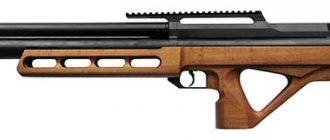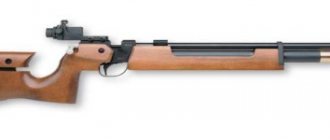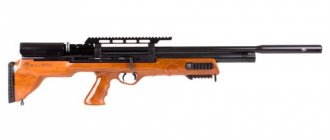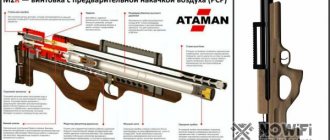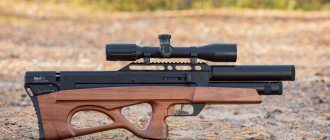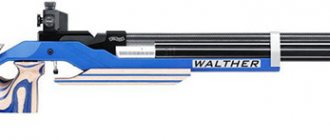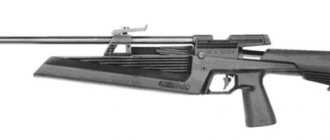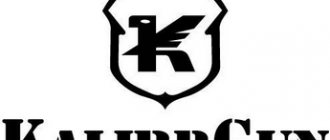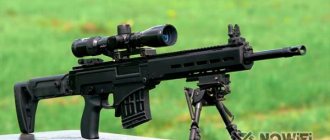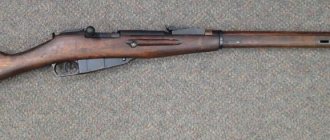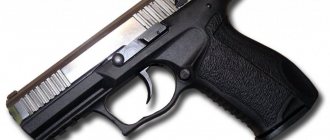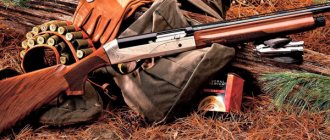How to lubricate an air rifle
What exactly should I lubricate with?
Can you tell me the name? I think I understand what you mean. But do you also need grease inside the “working” space? And in general, what is the composition and where can I buy it? Can you be more specific?
The most easily accessible is CV joint-4. It comes in small tubes at any auto parts kiosk. And at the gas station.
Do you have castor oil, would it work?
I don't find anything funny, I feel sorry for things. It’s good at least it’s not Weirauch in this case, for example. The question, of course, is the ability to self-learn, but what’s surprising is that in the information age, people can’t help but google it. Timan at one time also smeared Gama with sunflower, but then he had real problems with the Internet, and now he gets calls from all over the country about steering with rifles
Well, castor oil is not sunflower oil at all. The flash point is high, which allows it to be used in motors. The debate about synthetics or castor oil is still raging. Well, if the PPP compressor is sometimes lubricated with synthetics, castor oil is definitely no worse in this sense.
It may thicken over time, but I have never encountered it in such a way that it polymerizes like sunflower.
But CV joint-4 is better, yes.
I’m used to trusting this store and its employees, so I only read the instructions on the bottle by accident and at home. And there, in black and gold, firstly, “Do not use for lubricating electrical contacts,” and secondly, a whole ode about how great it is to lubricate various mechanisms with this oil. If the manufacturers themselves write this, it is not surprising that the consumer burns with silicone every now and then. I just don’t understand, but it’s not suitable for electrics, if it’s really silicone - the same silicone Liqui-Moly from the same store is taken for exactly this purpose and it says about wiring, and high-voltage, and not about low-voltage. Hez, maybe this is a vague warning against splashing onto sparking contacts due to the presence of butane in the aerosol.
Gosh, I beg you! How much does it cost to write the letters you need on the label? Necessary instead of unnecessary. The employee will do it for a fee. Without any conspiracies and economic comparisons between efforts and results.
yes, the very word “silicone” fascinates some, they also proudly say that they lubricated it with silicone and not some kind of shit
Strange. The main component is mineral oil. And it’s no good!?
quote: Originally written by gnom: But the rear belt of the piston must be lubricated with any grease, at least lithol.
To what extent is this a necessary condition for it to be consistent? Always (after preliminary complete removal, a little less than two cars, and degreasing, just in case), I usually took a domestic weapons-grade neutral (“Berkut” or something like that). I smeared the cuff along the edge, a little behind the piston, a little more on the spring, trigger and other mechanics. I didn't seem to notice any problems. For about three years, instead of the domestic neutral one, I’ve been using ballistol, and experimenting a little with Nanoprotect. Did I do something wrong?
Composition: 100ml. Vaseline oil + 25 ml. kerosene + 20 ml. turpentine.
I just bought the components yesterday.
Why do they need to smear the TRUNKS?
By “barrels” I meant weapons in general. quote: Originally posted by Non-Fuzzist: Kerosene and turpentine, as we understand, are not the best option for a model diesel engine, which is the PPP.
But diesel almost never happened. Only at the beginning, the first shots are 10. And this is with such and such a composition. Hmmm, a mystery though.
quote: Originally posted by Non-Fluffy: It is “poor” in lubricating properties. And over time it forms a film, i.e. it polymerizes. TO
You will need to thoroughly disassemble your Di to see what has polymerized there over the course of more than three years. So, with incomplete disassembly, everything seems to be fine. It seems that everything is blurred and there is no film.
quote: Originally posted by Non-Fuzzist: just above is an example with a photo of silicone aerosol lubricant
I'm not even talking about silicone. And everything seems to be clear with him.
At most BPPs, absolutely any oil is enough, even a simple industrial oil, which, by the way, is all sorts of “wood grouse”, “special weapons oil”, etc. But if you take rifles like Norika, Hatsan and others with idiotic cocking kinematics, it is better to use grease at the rear, because The conditions there are very, very harsh.
quote: . Just don’t want to smear something on the engine barrels. I don't know why.
It is worth remembering that motor oil manufacturers are international giant corporations, with billions of dollars in revenue, their own research institutes, unique technologies, and so on. It's not even funny to compare them with. All this “special” mixture that we are used to “smearing trunks” with is the cheapest, basic mineral oil, and even diluted with solvents for better fluidity.. Comparing it with motor oil is like a station cheburek with a Prague restaurant..
quote: Originally posted by gnom: It is worth remembering that motor oil manufacturers are international giant corporations, with billions in revenue, their own research institutes, unique technologies and so on.
I remember about their research institutes. And about their technology too. And also about their love for all kinds of additives, which raises some concerns. Because I'm not a chemist. quote: Originally posted by gnom: All this “special” mixture that we are used to “smearing trunks” with is the cheapest, basic mineral oil
Is it really as bad as it sounds?! But in theory there should be a minimum of any additional goodness in the oil.
quote: Originally posted by gnom: Comparing it with motor oil is like comparing a station cheburek with a Prague restaurant..
More like a station cheburek with McDonald's. The Prague restaurant does not have its own research institute, but McDonald's does.
And by the way, one more point. If we use motor synthetics to lubricate the compressor and CV joint-4 (mineral water with a lithium thickener) for the rear part of the piston, won’t we get the reaction that is notorious to many motorists at the output?
The main thing is that the oil requirements, for our purposes, allow us to choose from many options. For me personally, I’ll probably prefer the good old neutral (Since ballistol is no good. I really don’t understand why. Yeah, I’ll take it on faith. ). After all, before experimenting with ballistol, I used it for 20 years. ICHH no problems were observed. Well, I’ll buy Shrus-4 for difficult cases, of course. Well, maybe I’ll experiment a little with Nanoprotect. The truth is that working with him gives me two feelings. On the one hand, in the form of a spray - convenient. But some kind of “sticky” infection. After it, purely from tactile sensations, it is unpleasant to finger the mechanism. But these are purely my cockroaches.
The only thing left to figure out is what to do with the leather cuffs. Something tells me that their lubrication must be approached even more subtly. Yesterday I read a lot about this topic and re-lubricated my spring pistol with neutral. I don’t understand whether it’s a little more oil or something. Today (when more than 50 shots are fired) a white “fog” flies out of the barrel. I look down the barrel, but there doesn’t seem to be any smoke. I suspect that the problem lies in the properties of the cuff material. Namely, in the ability to absorb excess oil, and in the absence of a tight fit to the cylinder walls during the reverse stroke. When it was smeared with ballistol, only the first ten shots saw such crap. Or is it better not to bother with this leather at all, and to make a polymer cuff on the knees from something suitable?
Step-by-step instructions for lubrication
Ignoring the procedure will result in severe contamination of the weapon. And if you overdo it, the owner will get a “smoke show”, lead or zinc coating throughout the bore. The main thing is consistency, but knowing when to stop.
Procedure for lubricating the gun:
- A small amount of oil (preferably mineral-based) is applied to the cleaning rod in the form of a spray - this makes it easier to control the flow rate, or rather the thickness of the applied layer on the surface of the barrel channel.
- The ramrod is inserted inside the barrel, which is in a vertical position. Slowly lubricate the part along its entire length. 2-3 dozen movements with the tool are enough, and after that the lubrication procedure is repeated several times. The operation comes to an end if the cleaning rod does not drain the weapon.
- It remains to process the remaining parts of the air pistol involved in the reproduction of shots. Especially if this has been done for a long time. It would be a good idea to lubricate the return spring, trigger mechanism, and blowback with a thin brush.
Upon completion of lubrication of the gun, 3 test shots must be fired to determine if there is any possible overshoot. If smoke is formed, but there is little of it, everything is in order. But, if it feels like shooting is being done from a double-barreled gun, there is a reason to correct the mistake by removing excess oil with a piece of rag (powder powder). The problem cannot be ignored, because plaque will form.
Cleaning an air rifle
Indeed, you may ask, why clean a rifle that shoots air? It is clean, it does not contain aggressive powder deposits that corrode the metal. Well, first of all, the air is not that clean. Secondly, the main reason for the need for cleaning is completely different. It is determined structurally - a combination of a steel barrel and soft lead ammunition.
Whenever a shot is fired from an air rifle, the bullet, sliding along the bore and its rifling, leaves a piece of itself on them. This process is called “lead barrel.” Its intensity directly depends on the power of the rifle - the higher it is, the more chips are removed from the bullet. Lead leaves the main traces on the breech of the barrel, approximately in its first third. But if the rifle barrel has a narrowing - a choke, then so does the front muzzle.
Rifles with polygonal rifling are less likely to be leaded.
The second most important reason why cleaning air guns is necessary is the use of fairly soft, low-carbon steel for the production of air gun barrels. It is susceptible to corrosion. To a small extent, but still sufficient to render the rifle inoperable if the owner is completely inattentive to the weapon. Most often, the barrels of weapons that use CO2 cylinders as the working fluid of the shot rust. A shot from them is always accompanied by cooling, and therefore by condensation of atmospheric moisture. In addition, refillers of siphon cylinders do not particularly care about drying out the carbon dioxide, and the bullet is pushed down the barrel by a mixture of carbon dioxide and water.
In spring-piston rifles, another source of barrel contamination is piston conservation lubricant. If it is not removed, then when a shot is fired, the same effect occurs as when a diesel engine is running - the air heated by sharp compression ignites the lubricant, and all residual combustion products fly into the barrel. By the way, they are quite aggressive. Almost like gunpowder residue.
Basic Rules
A responsible airgun manufacturer will always indicate after what number of shots the airgun barrel needs to be cleaned. Typically this number ranges from one hundred to two hundred shots. But you can see for yourself that the rifle simply cries out for the need for cleaning. The first sign of this is a decrease in accuracy. The rifle, simply put, starts spitting bullets in different directions. The second is the enhancement of the diesel effect, characteristic of rifles with a spring-piston design. It is very beautiful - smoke from the trunk, and at night there is also a sheaf of sparks. It is only very dangerous for the rifle mechanism, especially the sealing cuffs. With a strong diesel engine and a tightly leaded barrel, the piston can go back on its own, breaking the trigger mechanism.
Process
The air rifle barrel is cleaned from the end into which the cleaning rod can be pushed. For rifles with a broken barrel, this can be either the breech or the muzzle at the front sight.
Complete cleaning with lead removal consists of three stages:
- removal of lead plaque;
- degreasing the barrel;
- drying;
- lubricant
The lead coating on the trunk is relatively weak. The effort to remove it may be enough to make you sweat, but it cannot be said that it is a hopeless matter. A practical and reliable tool in this matter is a bronze brush. The hardness of the non-ferrous metal is enough to tear off lead, but not enough to harm the steel barrel.
When cleaning spring-mechanical rifles with an under-barrel or side cocking lever, it is necessary to protect the bypass hole from particles of oil mixed with lead and bronze crumbs from the brush getting into it. Otherwise, the very first shot will produce such a powerful “diesel” that the cleaning will have to be repeated again.
Cleaning the barrel of an air gun:
After removing the lead coating, the barrel is degreased. Mainly to remove oil contaminated with lead and bronze. It is strictly forbidden to use gasoline, diesel fuel or kerosene for this purpose. Only those types of solvents that have maximum volatility. For example, acetone. This will ensure that by the time the shot is fired there are no flammable vapors left in the barrel or compressor. The bypass hole must also be securely closed during the barrel degreasing process. When degreasing the barrel, a nylon brush is usually used. It must be tested for solvent resistance, otherwise, in addition to lead, you will get a polymer coating on the barrel.
Posts 1 page 20 of 20
Share12010-07-01 18:57:44
- Author: Evgen
- Private
- From: Novosibirsk
- Registered: 2010-06-13
- Invitations: 0
- Posts: 68
- Respect: [+0/-0]
- Positive: [+0/-0]
- Gender: Male
- Age: 36 [1985-06-02]
- Time spent on the forum: 16 hours 58 minutes
- Last visit: 2011-02-05 19:59:17
I lubricate it with gun grease, when I fire it smoke comes out of the barrel! Although I lubricate it within reasonable limits, I don’t fill it with buckets)) How can I lubricate the piston and cylinder itself??
Share22010-07-01 19:11:47
- Author: IzhSniper
- Administrator
- From: Izhevsk
- Registered: 2010-01-21
- Invitations: 0
- Posts: 282
- Respect: [+10/-0]
- Positive: [+2/-0]
- Gender: Male
- Age: 32 [1989-10-03]
- Time spent on the forum: 6 days 19 hours
- Last visit: 2019-02-19 09:29:01
CV joint, literally one gram is enough for the entire rifle. Nothing disilites.
Share32010-07-01 19:52:26
- Author: kipish
- General
- From: Izhevsk
- Registered: 2010-01-21
- Invitations: 0
- Posts: 496
- Respect: [+1/-0]
- Positive: [+0/-0]
- Age: 51 [1970-05-01]
- Time spent on the forum: 8 days 4 hours
- Last visit: 2016-08-09 19:34:53
Wipe the piston cylinder and cuff dry with a rag, then dirty the rag with the CV joint and wipe the cylinder, piston and cuff
Share42010-07-01 21:12:07
- Author: Hemulen
- Colonel
- Registered: 2010-02-22
- Invitations: 0
- Posts: 353
- Respect: [+1/-0]
- Positive: [+0/-0]
- Gender: Male
- Age: 29 [1992-03-14]
- Time spent on the forum: 3 days 8 hours
- Last visit: 2014-01-31 18:17:26
We have one guy here who lubricates his IZH61 rifle with waste motor oil. Then she shot black blots like a paintball marker
Share52010-07-04 19:32:36
- Author: Evgen
- Private
- From: Novosibirsk
- Registered: 2010-06-13
- Invitations: 0
- Posts: 68
- Respect: [+0/-0]
- Positive: [+0/-0]
- Gender: Male
- Age: 36 [1985-06-02]
- Time spent on the forum: 16 hours 58 minutes
- Last visit: 2011-02-05 19:59:17
My regular gun lubricant (neutral) produces white smoke from the barrel. Diesel? Although I don’t pour buckets of it into the compressor.
Share62010-07-04 23:24:02
- Author: hrundeel
- Marshal of the Forum
- Registered: 2010-01-22
- Invitations: 0
- Posts: 1035
- Respect: [+4/-0]
- Positive: [+3/-1]
- Time spent on the forum: 14 days 13 hours
- Last visit: 2019-05-28 15:43:58
And you don’t even need buckets. Even with more or less normally removed lubricant from the cylinder, the diesel engine will still fire 50 shots.
Share72010-07-05 13:29:02
- Author: Evgen
- Private
- From: Novosibirsk
- Registered: 2010-06-13
- Invitations: 0
- Posts: 68
- Respect: [+0/-0]
- Positive: [+0/-0]
- Gender: Male
- Age: 36 [1985-06-02]
- Time spent on the forum: 16 hours 58 minutes
- Last visit: 2011-02-05 19:59:17
I have already fired more than 50 shots since the lubrication, but it still smokes (Is this very harmful for pneumatics?
Share82010-07-05 14:56:34
- Author: kipish
- General
- From: Izhevsk
- Registered: 2010-01-21
- Invitations: 0
- Posts: 496
- Respect: [+1/-0]
- Positive: [+0/-0]
- Age: 51 [1970-05-01]
- Time spent on the forum: 8 days 4 hours
- Last visit: 2016-08-09 19:34:53
Is this very harmful for pneumatics?
The piston can easily burn out, take it apart, wipe everything dry, lubricate it with a thin CV joint
Share92010-07-05 18:30:11
- Author: Evgen
- Private
- From: Novosibirsk
- Registered: 2010-06-13
- Invitations: 0
- Posts: 68
- Respect: [+0/-0]
- Positive: [+0/-0]
- Gender: Male
- Age: 36 [1985-06-02]
- Time spent on the forum: 16 hours 58 minutes
- Last visit: 2011-02-05 19:59:17
I've had it for a very long time. smokes all the time)))) Recently I completely disassembled it (for the first time after 8000-10000 shots) Everything inside is fine, the cuff really has a brown coating on it, well, I still need to change it. And the rest is ideal. By the way, does it make sense to sand all the touching parts? Or leave it like that? They've already gotten used to it.
Share102010-07-07 08:34:34
- Author: Vlad_R
- Sergeant
- From: Tchaikovsky
- Registered: 2010-03-22
- Invitations: 0
- Posts: 109
- Respect: [+0/-0]
- Positive: [+0/-1]
- Gender: Male
- Age: 67 [1954-04-12]
- Spent on the forum: 1 day 12 hours
- Last visit: 2014-10-23 21:02:23
I've had it for a very long time. smokes all the time
Igor gave you definitely the right advice. Disassemble, re-lubricate with CV joint. You can apply the CV joint to the cuff, insert the piston and move it around the compressor with your hands, the cuff will remove the excess and remove it. Fsyo. It’s not difficult to answer your questions, but it’s all been chewed over 100 times on https://talks.guns.ru/forumindex/8.html, I recommend it. There are few such resources where almost everything according to our hobby is dumped. Good luck.
Share112011-06-13 21:51:04
- Author: Sodium Chloride
- Captain
- From: Malaya Purga
- Registered: 2010-02-06
- Invitations: 0
- Posts: 221
- Respect: [+2/-0]
- Positive: [+0/-0]
- Gender: Male
- Age: 44 [1977-01-13]
- Time spent on the forum: 5 days 19 hours
- Last visit: 2021-11-20 22:53:00
I, too, have everything lubricated with CV joint 4 on my Murki (the outer surface of the piston and spring, bolt, parts of the trigger mechanism.) But not so long ago I lubricated the bearings of the washing machine with CV joint (I ran out of CIATIM). So these bearings immediately crunched. I had to wash them and go in search of another lubricant. Having become interested in this, I googled it and found that I was not the only one who noticed such properties. Moreover, there are opinions that the CV joint should only operate in sealed units, otherwise the molybdenum disulfide included in it under the influence of “natural factors” (such as oxygen and atmospheric moisture) is converted into molybdenum dioxide, i.e. into abrasive I won’t panic, but if necessary, I will replace all the lubricant, at least with LITOL 24.
Source
Features of cleaning different models
The most unpretentious models are those that use CO2. Any mechanical dirt is simply blown out of them. However, the presence of moisture in the cylinder and the effect of its condensation during firing make the barrel lubrication procedure mandatory. The same requirement also applies to models with pre-pumping or with a multi-spring, into the reservoir of which air is pumped from the street.
In spring-mechanical rifles, it is imperative to protect the bypass hole from lubricants and solvents getting into it. The best way to “kill” such a rifle is to drop oil, diesel fuel, acetone, and gasoline into the compressor (in order of increasing strength of the diesel effect).
Accessories
To clean your rifle you will need:
- cleaning rod – folding or solid, it doesn’t matter;
- bronze brush;
- nylon brush;
- Visher;
- dry, clean, thin cotton fabric;
- Ballistol gun neutral oil;
- acetone.
The ideal cleaning rod is bronze. The steel one must be protected with plastic film (you can use cocktail straws).
A bronze brush is a consumable item; it can go bald within one cleaning. Used to remove lead plaque.
Nylon brush - for lubricating and degreasing the barrel.
Visher is a ramrod attachment that pushes fabric along the bore. The most common visher is a flattened wire with a long slit into which a piece of fabric is pushed. It can scratch the trunk, and the patch (rag) moves unevenly along the trunk, leaving untreated areas. The ideal visher is a bronze cylinder with a spiral groove. It does not scratch the barrel and cleans it in one pass.
If you cannot do without lubricant - in the off-season for all models of rifles, and in other cases - for those operating on CO2, use the most liquid, neutral in reaction. The ideal option is Ballistol.
Photo of a kit for cleaning air guns
Recommendations for lubricants
There are many lubricants on the market, but which one is best for a pistol user? The main thing is that the lubricant is of the aerosol type - it is economical and controls the application of layers.
What pneumatic pistol owners recommend using:
- Ballistol is the TOP among weapon oils. The product is certified and manufactured to high standards. The composition includes natural materials, which gives the weapon good operating characteristics. The weapon will definitely receive reliable protection. There are also silicone-based ones under this trademark. Treating weapons with it is a bad idea. It is better to use it to lubricate small elements of a weapon, for example, the trigger mechanism.
- Brunox (universal) . Another certified product manufactured to high standards. Excellent oil in a convenient bottle. It can be used not only for processing “aircraft”, but also firearms samples. It’s easy to purchase – the product is sold in almost every gun market.
- Ustanol (neutral) . Suitable for periodic processing and preservation of pneumatics. It covers the surface with a thin protective film that prevents rust from forming. The lubricant composition is resistant to high temperatures, so it can be used on firearms.
- Guns Spray . It's not a cheap option, but it's worth it. It is used to process all functional elements of air guns. The frost-resistant base allows you to use the gun in winter. The composition does not contain silicone and Teflon. The formation of unwanted compounds is excluded.
There is a larger selection of lubricants, but these options are more often used by amateurs and professionals. You can use any, but it is worth noting the fact that a cheap option does not mean a bad one. Buying the latter option is not necessary. It is enough to take proven, affordable, high-quality Ballistol oil - the weapon will definitely respond with gratitude.
How to properly clean air rifles
All rifles need cleaning, and air guns are no exception. Caring for an air rifle is the key to flawless operation of the air rifle.
Many people believe that there is little point in cleaning pneumatic guns, since shooting with air does not imply the appearance of gunpowder deposits on the barrel, which negatively affects the metal. However, cleaning must be done for other reasons, which is determined by the combination of the steel barrel and lead ammunition.
Cleaning an air rifle
After each shot from an air rifle, the bullet slides along the bore and its rifling. Thus, the projectile leaves its microparticles on the surface - this is called lead plating of the barrel. Moreover, the higher the power of the weapon, the more lead the bullet loses. Basically, lead “lies” on the first third of the barrel, its breech, and if there is a narrowing of the rifle barrel - the choke - then in the area of the front muzzle. Rifle models with polygonal rifling are less susceptible to lead.
In addition to the power of the lead, the intensity of the lead is also affected by the quality of the bullets. However, the ammunition leaves the usual contaminants in the barrel. To keep the barrel clean, it is recommended to simply pre-wash the lead bullets.
Another reason that necessitates regular cleaning of air rifles is barrels, the production materials of which are soft steels with an insufficiently high carbon content. Such steels are characterized by corrosion. Even small manifestations of it on a rifle left unattended by the owner can render the weapon inoperable. The barrels of gas-cylinder type rifles - CO2 - are especially susceptible to rust. Each shot from such a weapon is followed by cooling, and as a result, the formation of condensation. Often, when filling a siphon cylinder, dehydration of carbon dioxide is not used, as a result of which the bullet is pushed out of the barrel with a mixture of carbon dioxide and water.
Spring-piston rifles have another source of barrel contamination - piston lubricant, which is used to preserve it. When lubricant remains on the piston, an effect characteristic of diesel engines occurs. When the air is sharply compressed, the lubricant ignites, and as a result the barrel becomes contaminated with all the residual combustion products, which are almost as aggressive as powder soot.
Cleaning Rules
Serious manufacturers of air rifles indicate how often and after how many shots it is necessary to clean the barrel of the weapon. Usually every 100–200 shots. An attentive shooter will notice when he needs to pay attention to cleaning his weapon. The first sign of this is a decrease in accuracy. The second, characteristic of spring-piston models, is that when firing, smoke will begin to come out of the barrel, and in poor lighting you may notice the appearance of sparks. This has a very negative effect on the pneumatic mechanism, especially on the sealing cuffs. Severe contamination of the rifle can cause the piston to move backward on its own and cause the trigger mechanism to break.
How to clean an air rifle barrel - steps:
- remove lead plaque;
- degrease the barrel;
- dry the barrel;
- lubricate the barrel.
You may have to sweat to remove the lead coating, but this should not be a difficult task for an adult male. To complete this process, it is recommended to use a bronze brush. The non-ferrous metal is hard enough to handle lead and tear it away from the trunk, while at the same time it is harmless to the trunk itself.
To wash away lead flakes and reduce friction, use Ballistol liquid oil or spindle oil diluted with kerosene in a 1:3 ratio.
If you are cleaning spring-action rifles that have an underbarrel or side cocking lever, you should make sure that the bypass hole is protected from the penetration of oil particles, lead, and bronze brushes. Otherwise, after the first shot, the barrel may need to be cleaned again.
When the lead coating is removed, the barrel should be degreased - remove oil contaminated with lead and bronze. Do not degrease the barrel with gasoline, diesel fuel or kerosene. It is allowed to use solvents that are characterized by high volatility - for example, acetone. After its use, the presence of flammable vapors in the bore or compressor is excluded. Before degreasing the barrel, the bypass hole should be closed. It is recommended to use a nylon brush during the process. It must be resistant to the solvent you use, otherwise the lead will add polymer coating to the bore.
Instead of degreasing, you can use drying. It can be done using pieces of dry cloth or cotton pads for removing makeup. The best option for drying is a wisher - a special attachment that is screwed onto the cleaning rod.
It is made of bronze and has a screw groove into which you need to insert a narrow strip of material. Drying in patches is carried out until no traces of oil or other contaminants remain on the fabric.
Lubricating the barrel in a thin layer ensures easier movement of the projectile along the bore. For an air rifle, it is important to choose the correct consistency and amount of lubricant - it should only be liquid. How to lubricate an air rifle? An excellent option is Ballistol neutral gun oil, but its layer must be of a minimum thickness. Otherwise, you can’t count on accurate shooting.
Cleaning process
Now that we have understood the basic rules of cleaning, let's take a better look at the procedure itself. Rifle maintenance consists of four steps that must be followed in strict sequence. Here's a quick guide:
Step 1 - removing lead plaque
First, we need to get rid of the carbon deposits that formed during the shooting process. To do this, take a brush (plastic or bronze), then immerse it inside the barrel and begin cleaning the rifle with smooth and accelerated movements. This procedure should take at least 5 minutes: if plastic or bronze cannot cope with plaque, then you can use harder metals.
Step 2 - degreasing the barrel
As soon as the carbon deposits are removed, it is necessary to treat the barrel with kerosene or a special chemical liquid that removes oil. To do this, take a piece of rags or puff, moisten it in a chemical composition, string it onto a cleaning rod, and then treat the barrel. As soon as the tip is dry, wet it again and repeat the procedure until there is no oil left in the barrel.
Step 3 – washing and drying
After degreasing the barrel, we will have to get rid of the remaining kerosene. A soap solution or water diluted with detergent (AOS, Fary) is best suited for this purpose. We thoroughly wash the barrel with a cleaning rod and rags, and then place it in a warm place to dry with the muzzle down. If you don’t have time for this, you can use a hairdryer.
Step 4 - Lubrication
Once the barrel is cleaned and completely dry, you can begin the lubrication process. In this case, it is very important to observe moderation, because an excess of oily composition will lead to faster formation of soot. Smoke from the barrel is, of course, very beautiful, but it is harmful to the “health” of the rifle. So don't overdo it, otherwise you'll have to repeat everything.
After this, the rifle is completely ready to fire.
Remember that the life of the weapon directly depends on how well and often you clean and lubricate. No matter how unpretentious a rifle is, everyone needs minimal maintenance.
Caring for bullets
If you want to have a serviceable and durable air rifle, make sure your bullets are clean. Russian-made ammunition is especially contaminated. If you bought these bullets, you should do the following:
- pour them into a jar, pour kerosene or diesel fuel into it;
- drain the oil products and dry the bullets;
- put the bullets in a clean container, pour AOS type dishwashing detergent into it;
- Place the ammunition in an even layer on a sheet of paper and wait until it dries, or speed up the process with a hairdryer.
Clean bullets should not be sticky or leave a black, oily residue.
Cleaning different types of rifles
The easiest way to clean gas-type pneumatics is CO2. Any mechanical dirt can simply be blown out of them. At the same time, if the cylinder contains moisture and condensation forms in the channel, the barrel lubrication procedure is mandatory. This also applies to pre-inflated rifles - PCP - and multi-compression models. Owners of spring-piston rifles should take care to protect the bypass hole from lubricant and solvent. You can shorten the life of such a rifle by dropping oil, diesel fuel, acetone or gasoline into the compressor.
For all rifles, it is necessary to lubricate the external parts - hinges and locking parts in models with reloading by breaking the barrel and lever, and air tank valves. Liquid “spindle” oil under the trigger will be helpful.
Cleaning accessories
Cleaning the rifle should be done with a folding or fixed cleaning rod, a bronze and nylon brush, a visher, a dry and clean cotton cloth, Ballistol neutral weapon oil, and acetone.
The ideal cleaning rod is one made of bronze. Steel cleaning rods must be protected with a plastic film. A bronze brush removes lead deposits; the instrument wears out quickly - after one cleaning it can become “bald”. A nylon brush is used to lubricate and degrease the barrel bore.
A visher is a ramrod attachment that serves to push fabric through the barrel. The common visher is made in the form of a flattened wire with a long slit - a piece of fabric is pushed into it. The disadvantage of such a visher is the risk that it will leave scratches on the barrel, and the patch may also treat the barrel unevenly. The ideal option is a bronze visher in the form of a cylinder, which has a spiral groove. This kind of visher does not scratch the barrel and cleans its channel in one pass.
For those who cannot do without lubrication - during the off-season for pneumatics of all types, and in other cases - for gas-cylinder models, it is recommended to use the most liquid, neutral oil. The best lubricant option for pneumatics is Ballistol.
How to lubricate a rifle compressor
I lubricate my Huts 70 with WD-40, but I heard rumors (from a friend) that there is a special lubricant that can increase (slightly) the power of pneumatics, due to minimal friction of parts.
here is a review of WD-40 - a universal-purpose technical aerosol, a unique product whose qualities surpass those of traditional light lubricants, dispersion oils, water-repellents, metal cleaners, and silicone aerosols. The product does not contain silicone, hence the surface coated with WD-40 will not be sticky or oily and therefore will not attract dust or dirt, and what's more, WD-40 is an ideal cleaning agent for all moving parts of machinery.
